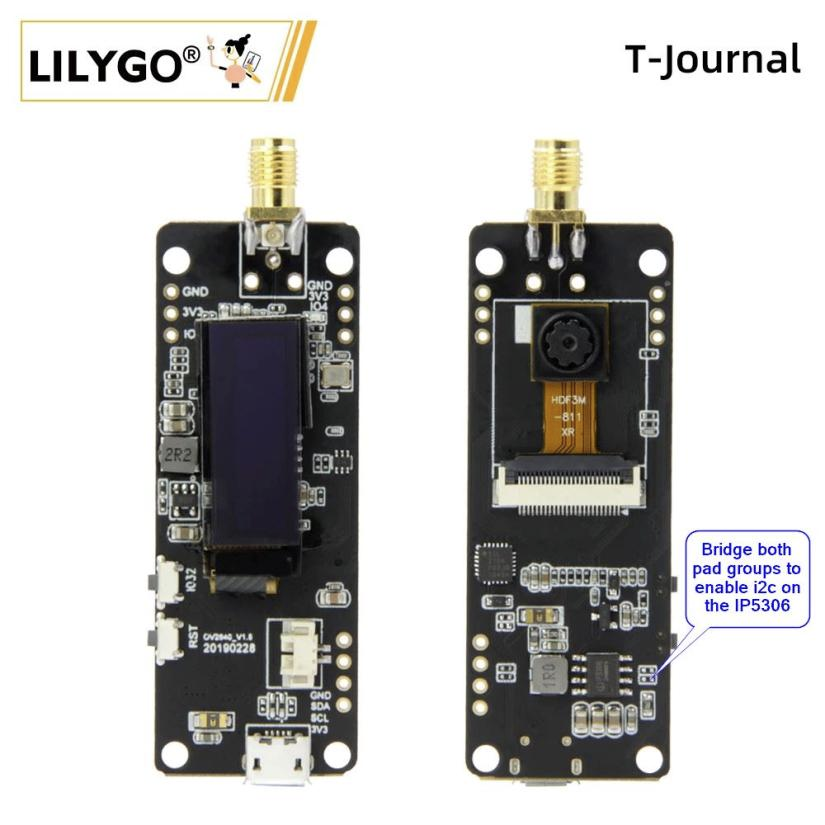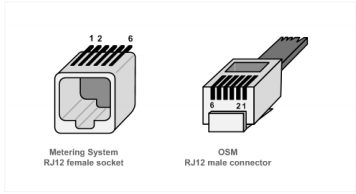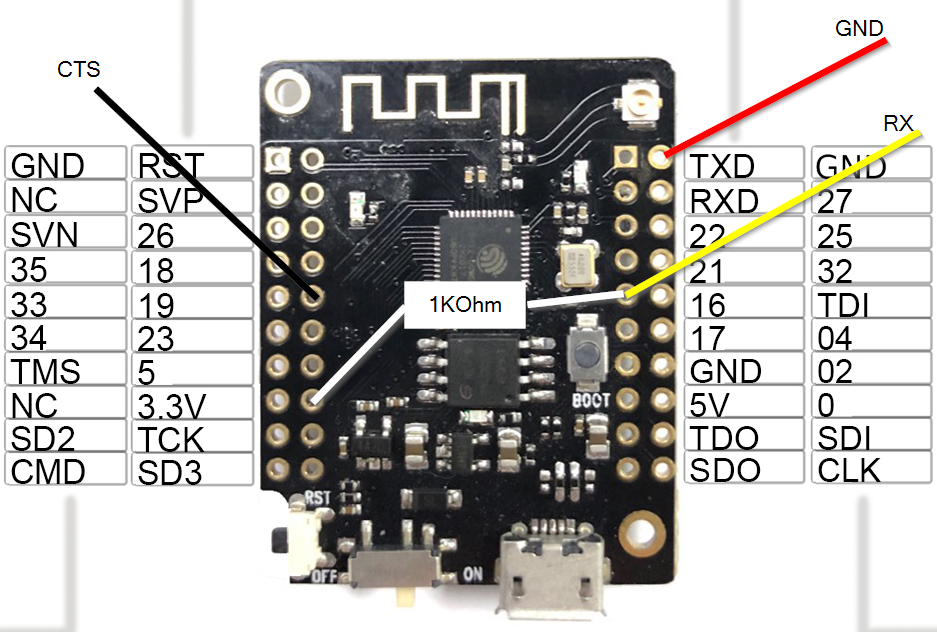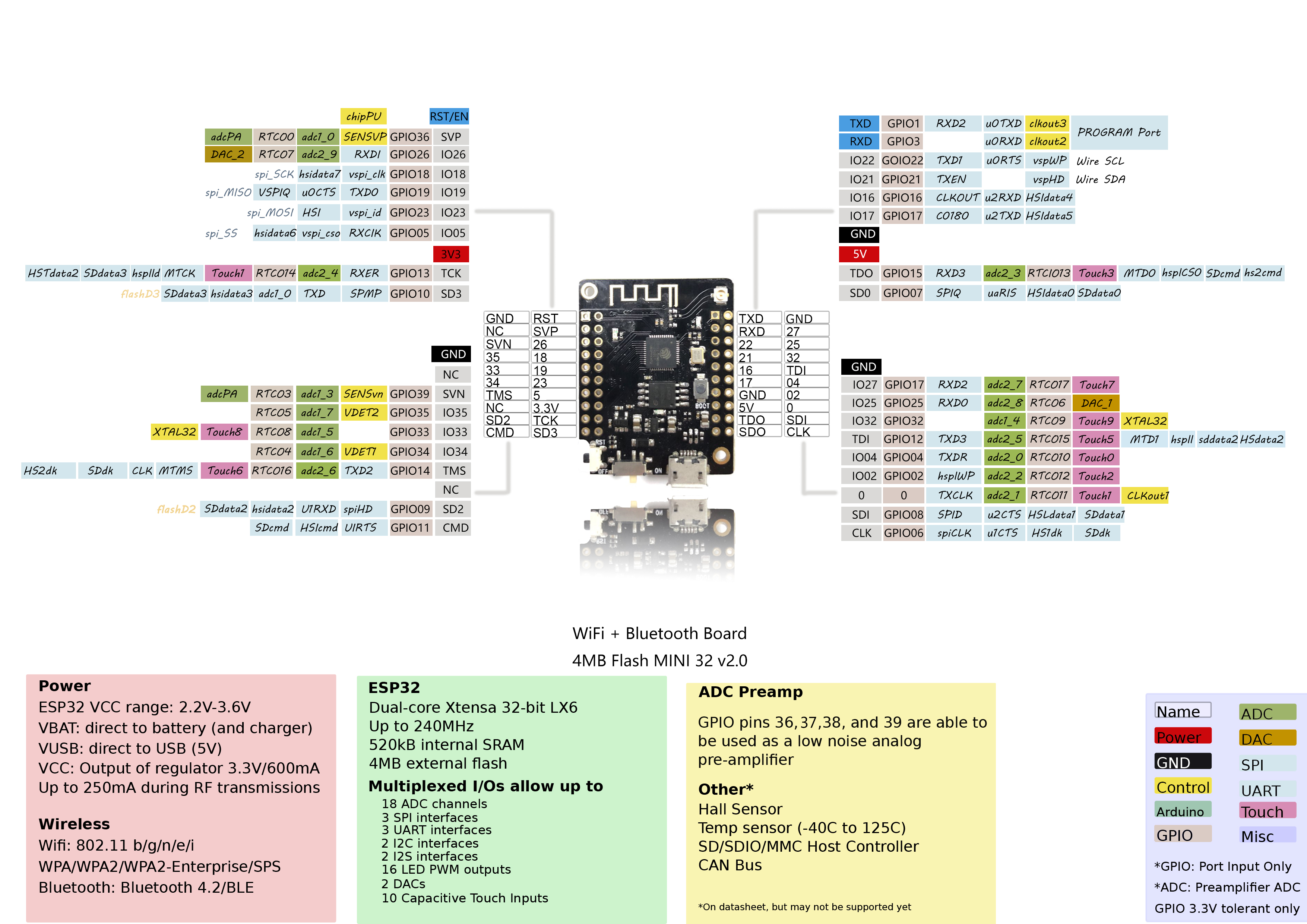Actions
Esphome » Geschiedenis » Revisie 9
« Vorige |
Revisie 9/12
(diff)
| Volgende »
Micha Kersloot, 14-04-2023 20:12
Esphome¶
TTGO T-Journal¶
The T-journal is able to communicate the battery state over i2c. After bridging the pads as shown in the picter the IP5306 that is used is connected to pins 13 (scl) and 14 (sda).

working configuration:
substitutions:
device_name: "cam01"
esphome:
name: '${device_name}'
esp32:
board: esp32dev
framework:
type: arduino
# Enable Home Assistant API
api:
encryption:
key: "xxxxxxxxxxxx"
ota:
password: "xxxxxxxxxxxxx"
wifi:
ssid: !secret wifi_ssid
password: !secret wifi_password
# Enable fallback hotspot (captive portal) in case wifi connection fails
ap:
ssid: "cam01 Fallback Hotspot"
password: "xxxxxxx"
captive_portal:
external_components:
- source:
type: git
url: https://github.com/MichaKersloot/esphome_custom_components
components: [ ip5306, esp32_camera ]
i2c:
- id: bus_a
sda: 14
scl: 13
frequency: 400kHz
scan: true
ip5306:
battery_level: # sensor
name: '${device_name} - Battery Level'
charger_connected: # binary_sensor
id: connected
on_press:
then:
- lambda: ESP_LOGD("TEST", "charging");
on_release:
then:
- lambda: ESP_LOGD("TEST", "not charging");
charge_full: # binary_sensor
id: full
on_press:
then:
- lambda: ESP_LOGD("TEST", "fully charged");
on_release:
then:
- lambda: ESP_LOGD("TEST", "still charging");
esp32_camera:
name: '${device_name} - camera'
external_clock:
pin: GPIO27
frequency: 20MHz
i2c_pins:
sda: GPIO25
scl: GPIO23
data_pins: [GPIO17, GPIO35, GPIO34, GPIO5, GPIO39, GPIO18, GPIO36, GPIO19]
vsync_pin: GPIO22
href_pin: GPIO26
pixel_clock_pin: GPIO21
agc_gain_ceiling: 8x
# jpeg_quality: 16
# max_framerate: 25Hz
contrast: 0
brightness: 1
saturation: 0
ae_level: 2
# aec2: True
horizontal_mirror: false
vertical_flip: false
resolution: 800x600
esp32_camera_web_server:
- port: 8080
mode: stream
- port: 8081
mode: snapshot
If you are unable to program:
python -m esptool --chip esp32 --port COM5 --baud 115200 --after hard_reset erase_flashand if even that doesn't solve it:
python -m esptool --port COM5 write_flash_status --non-volatile 0p1 dsmr power meter with TTGO T7 v1.3 mini¶
I'm using a TTGO T7 v1.3 mini and a piece of a dutch phone cable with an RJ11 connector. I soldered the cable directly on the board.

On RJ11, pin 1 and pin 6 are not connected / available
| RJ11 P1 | ESP32 Pin | 4w cable | comments |
|---|---|---|---|
| 2 - CTS | GPIO19 | black | Clear to Send, High = allow P1 Meter to send data |
| 3 - Data GND | GND | red | |
| 4 - nc | - | green | |
| 5 - RXD (data) | GPIO16 | yellow | 1K external pull-up resistor needed |

Working configuration:
substitutions:
name: p1meter
friendly_name: p1meter
esphome:
name: ${name}
friendly_name: ${friendly_name}
esp32:
board: ttgo-t7-v13-mini32
framework:
type: arduino
# Enable logging
logger:
# Serial logging is disabled by setting the logger baud rate to 0.
# Otherwise the logger will occupy the hardware UART, making it unavailable
# for receiving smart meter data on pin D7 (GPIO13).
baud_rate: 0
# Enable Home Assistant API
api:
encryption:
key: "xxxxxxxxxxxxxxxxxxxx"
ota:
password: "xxxxxxxxxxxxxxxxxxxxx"
wifi:
ssid: !secret wifi_ssid
password: !secret wifi_password
# Enable fallback hotspot (captive portal) in case wifi connection fails
ap:
ssid: "P1Meter Fallback Hotspot"
password: "xxxxxxxxxxxxx"
captive_portal:
uart:
id: uart_bus
rx_pin:
number: GPIO16
inverted: true
baud_rate: 115200
rx_buffer_size: 1700
dsmr:
request_pin: GPIO19
sensor:
- platform: dsmr
energy_delivered_tariff1:
name: Energy Delivered Tariff 1
state_class: total_increasing
energy_delivered_tariff2:
name: Energy Delivered Tariff 2
state_class: total_increasing
energy_returned_tariff1:
name: Energy Returned Tariff 1
energy_returned_tariff2:
name: Energy Returned Tariff 2
power_delivered:
name: Power Consumed
power_returned:
name: Power Returned
electricity_failures:
name: Electricity Failures
electricity_long_failures:
name: Electricity Long Failures
voltage_l1:
name: Voltage L1
voltage_l2:
name: Voltage L2
voltage_l3:
name: Voltage L3
current_l1:
name: Current L1
current_l2:
name: Current L2
current_l3:
name: Current L3
power_delivered_l1:
name: Power Delivered L1
power_delivered_l2:
name: Power Delivered L2
power_delivered_l3:
name: Power Delivered L3
power_returned_l1:
name: Power Returned L1
power_returned_l2:
name: Power Returned L2
power_returned_l3:
name: Power Returned L3
gas_delivered:
name: Gas Delivered
text_sensor:
- platform: dsmr
identification:
name: Identification
p1_version:
name: Version

meer dan 2 jaar geleden bijgewerkt door Micha Kersloot · 12 revisions